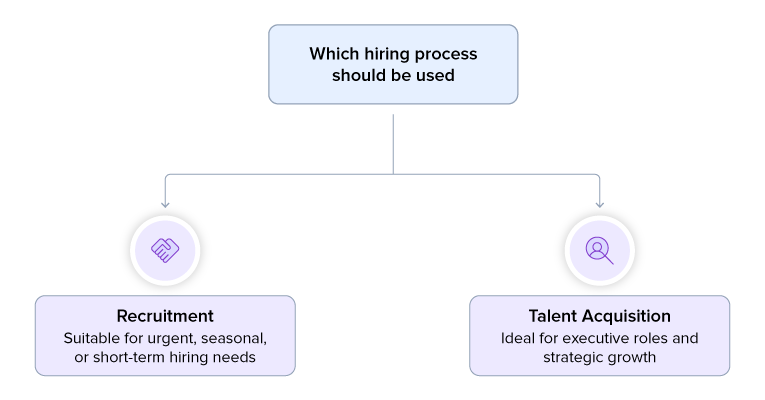Recruitment vs Talent Acquisition: Know the Difference!

Table of Contents
Recruitment and talent acquisition are terms often used interchangeably, but recruitment vs talent acquisition actually refers to different processes. While both involve hiring employees, understanding the difference helps HR managers plan their strategies better.
Recruitment focuses on filling job vacancies with qualified candidates. Talent acquisition, on the other hand, aligns hiring with long-term company goals by identifying, attracting, and retaining valuable talent.
Knowing this difference is important for HR managers to build a strong workforce. Let’s explore the distinctions between recruitment and talent acquisition in more detail.

What is Recruitment?
Recruitment is the tactical process of seeking, attracting, screening, selecting, and hiring suitable candidates to fill specific job vacancies. It usually begins with a job opening and ends when that position is filled. The objective is to have staff on the ground as soon as possible, continuing operations, and allowing positions to be readily filled with minimal production downtime.
Recruiting includes identifying the open position’s needs, posting job announcements, looking for potential applicants, and collecting resume applications. These are all important tasks in recruiting. It tends to be short-term in nature, it usually is business-led, and it aims to fill urgent gaps.
What is the HR’s Role in Recruitment?
HR professionals play a central role throughout the recruitment process. Their responsibilities include:
- Workforce Planning: Understanding current and future staffing needs, and aligning recruitment strategies with organizational goals.
- Job Analysis and Descriptions: Defining role requirements and ensuring job descriptions match actual needs.
- Candidate Sourcing: Attracting a diverse pool of candidates through various sourcing and networking strategies.
- Screening and Selection: Evaluating applications, conducting interviews, and ensuring selection of candidates who fit both the role and company culture.
- Onboarding: Supporting the new hire’s integration into the workplace for smooth transition and productivity.
What is Talent Acquisition?
Talent acquisition is a more strategic approach to hiring than recruitment. It involves analyzing an organization’s long-term goals and attracting talent. While it consists of the recruitment stages, the scope of talent acquisition is relatively broader.
Talent acquisition does not always fulfill an organization’s immediate hiring requirements. HR managers need to be far-sighted for this approach. They focus on human capital management (HCM) and build lasting relationships with them. They also make active attempts to retain the talent due to their valuable contribution to the company’s growth. For example, a product manager or a CTO can revolutionize their respective companies with dedication, talent, and hard work.
Talent acquisition is all about finding such professionals. It is about attracting candidates who are in tune with the company’s culture and can identify with its values.
The most common types of talent acquisition strategies include:
- Employer branding
- Talent marketing
- Extensive relationship-building
- Workforce planning
- Data analytics (to ensure long-term impact)
Talent acquisition is a slower process than recruitment. HR managers keep the ultimate organizational goals in mind while bringing on board deserving candidates. The employees hired this way won’t just fill job vacancies but also secure an organization’s future.
What is the HR’s Role in Talent Acquisition?
HR’s involvement in talent acquisition is multi-layered and strategic:
- Strategic Alignment: Collaborating with leadership to forecast long-term talent needs coordinated with organizational objectives.
- Talent Gap Analysis: Identifying future skills required and analyzing current workforce capabilities.
- Employer Branding & Talent Marketing: Designing campaigns and building a strong corporate image to attract quality talent.
- Relationship Management: Fostering ongoing connections with potential candidates, even when there are no current vacancies.
- Talent Management Initiatives: Supporting professional development and ensuring high-potential hires grow within the company.
- Continuous Evaluation: Monitoring hiring effectiveness and adapting strategies as business needs evolve.
So, how is talent acquisition different from recruitment? Let us explore the differences in detail.

Recruitment vs Talent Acquisition: Key Differences
Key differences between talent acquisition and recruitment can be understood by focusing on parameters such as time, scope, strategy, and others. Here are some of the key differentiators HR managers should focus on while choosing between Recruitment Vs Talent Acquisition
Time
The recruitment process in HR is typically shorter than the talent acquisition process. An effective HRMS can further reduce this time and help resolve many recruitment challenges. While recruitment is reactive, talent acquisition is proactive. Recruiters often aim to fill job vacancies on short notice. Talent acquisition professionals, on the other hand, spend more time analyzing organizational needs and assessing long-term goals before bringing on board the most suitable talent.
Strategy and Approach
The recruitment process in an organization is more direct and transactional. Its primary purpose is to find deserving candidates to fill job vacancies. Recruitment in HRM involves publishing job requirements, screening resumes, and choosing the right people for the right jobs.
Talent acquisition in HRM involves a longer approach to defining long-term organizational goals and developing strategies to attract and retain employees. The strategy here is to keep the bigger picture in mind while finding talent that would stay with the organization as it grows.
While considering qualifications and skills, recruiters often strive to close job openings quickly to maintain momentum. Talent acquisition professionals may or may not work on tight deadlines and nurture relationships even when there are no job openings.
The Screening Process
Recruitment is generally a shorter process than talent acquisition. The same is true for its screening of candidates. Recruiters focus on immediate job requirements while screening candidates. They shortlist employees if they possess the right skills needed for the specific jobs.
Talent acquisition typically involves a more comprehensive screening process. Here, HR managers ensure that a candidate fits into the organizational culture and is a good fit for the organization’s long-term growth. At the same time, candidates should always have the skills needed for their respective positions, and talent acquisition looks beyond the immediate job requirements. It considers aspects like a candidate’s personality, attitude, adaptability, scope for retention, long-term commitment, and more before bringing them on board.
Scope
The scope of talent acquisition is larger than that of recruitment when hiring employees. Recruitment focuses on individual job requirements and the skills an employee needs to perform them effectively. A candidate is hired if they have the skills required for the job.
When talent is acquired, professionals are expected to possess the required skills and be aligned with the company’s vision. It is this checking of all boxes that makes talent acquisition longer than recruitment.
Employer Branding
The role of employer branding in talent acquisition shouldn’t be overlooked. While some recruiters may use it to fill job vacancies, it is generally avoided in recruitment cases. Talent acquisition aims to hire employees in the long run. Employer branding is all about communicating an organization’s essence.
Here, the employer refers to the organization that is hiring the individual. Companies can reduce their recruitment costs with targeted employer branding. They promote their culture, perks, and goals to attract the right candidates. This ensures that the applications they receive include candidates who align with their long-term goals.
Here is a quick summary of recruitment vs. talent acquisition in a table covering the points discussed above, along with a few more:
| Aspect | Recruitment | Talent Acquisition |
|---|---|---|
| Process Length | Short-term process | Long-term process |
| Nature of Approach | Transactional, immediate | Strategic, holistic, future-focused |
| Main Objective | Fill vacancies | Attract and retain long-term talent |
| Employer Branding | Limited involvement | Actively invested in employer branding |
| Screening Process | Shorter, skills-based | Longer, includes cultural and potential fit |
| Urgency | Time-bound, urgent | Rarely urgent, more measured and flexible |
| Common Uses | Hiring for general employees | Executives, leaders, specialized/critical roles |
| Frequency | Conducted frequently | Less frequent, more targeted |
| Organizational Focus | Individual jobs | Long-term organizational goals |

When Should HR Managers Use Talent Acquisition vs. Recruitment?

Hiring employees is a responsible task. When new talent enters an organization, they bring opportunities, skills, and their vision. HR managers ensure that the employees they shortlist serve the purpose for which they are hired. Different circumstances require different hiring processes.
It is important to note that talent acquisition vs. recruitment is not always a “this or that” situation. Both processes are essential for an organization and can be streamlined with a modern human resource management system (HRMS). The difference lies in the primary purpose and specific hiring requirements.
Let us examine the circumstances under which HR managers should choose between recruitment and talent acquisition.
Scenarios Suitable For Recruitment
- Urgent projects that require employees
- Seasonal jobs
- Unexpected vacancies
- Short-term hiring
Scenarios Suitable For Talent Acquisition
- Hiring for executive roles
- The need for professionals when entering new markets
- Hiring for strategic growth
- The need for a healthy talent pipeline
How do You Choose the Right Role for Your Organization?
Deciding between recruitment and talent acquisition depends on your organization’s immediate and future goals:
- Assess Organizational Needs: Understand whether you need to rapidly fill positions or develop a talent strategy for future growth.
- Job Type: Use recruitment for high-volume or urgent roles; choose talent acquisition for specialized, high-impact positions.
- Budget and Resources: Consider if you have the resources and time for long-term strategic hiring or need swift action.
- Business Outlook: Stable industries may lean on recruitment; fast-changing or innovative sectors benefit from talent acquisition’s strategic scope.
Tip: Consider combining both approaches for optimal workforce planning and sustainable growth.

Conclusion
Understanding the difference between recruitment and talent acquisition is essential; it is equally important to recognize that an organization requires both of these processes. While recruitment fills immediate job vacancies and hires skilled employees, talent acquisition brings in employees who align with an organization’s long-term vision and values.
HR managers should focus on striking an ideal balance between the two to build a robust workforce. Whether they focus on recruitment or talent acquisition, HR managers need efficient HRMS (human resource management software) to streamline their tasks. factoHR helps these managers fill immediate job openings and find talent that meets long-term organizational goals.
The cloud-based human management software enables HR professionals to create job openings, scan resumes, generate interview questions, facilitate self-onboarding, and perform numerous other recruitment-related tasks.
Driven by new-age technologies like AI and machine learning, factoHR ensures that HR managers bring the best candidates on board. Request a free factoHR trial today to explore many more features that help your HR professionals with seamless recruitment and talent acquisition.
Grow your business with factoHR today
Focus on the significant decision-making tasks, transfer all your common repetitive HR tasks to factoHR and see the things falling into their place.

© 2025 Copyright factoHR


